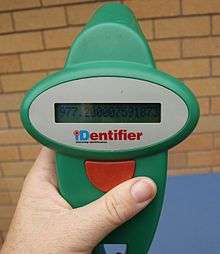Pet recovery service

A pet recovery service is a service that has been created for the specific purpose of reuniting lost or stolen pets with their owners.[1][2][3][4][5][6]
Pet recovery
Without identification tagging
A wide variety of pet recovery services exist, such as online services to search for lost pets. Less traditional services for searching for lost pets include use of a bloodhound, a pet detective, a "psychic", sites that offer advice or a bulk-calling computer that can quickly alert hundreds of neighbors by phone. It may also include websites that offer advice on how to conduct a search.
With identification tagging
External identification
Forms of external identification include collar tags with identifying information numbers or QR codes with the pet information or pet recovery service organization information. The pet could be tracked through a service toll-free number or web address on the tag; The service accesses the pet and owner information in a database via a number or QR code. Some pet identification tags include the owner's address or phone number that can be used to reunite the pet with its owner. There are also registry database services based on tattoo registries.
Electronic tracking devices
Collar-attached electronic tracking devices are used by recovery service providers to unite the pet with its owner. The contract may also include recovery services, which eliminates any need to rely on the pet encountering a helpful stranger. Although, at least one device does also call for help from anyone nearby.
Microchip implant
Since the early 1990s, the underskin I.D. tag or microchip implant has been promoted as a solution for pet recovery that does not require a collar. Veterinary services, animal shelters, and even some individuals have a chip scanner. In the U.S. such services are unregulated, and several types of chips have emerged with only some adhering to the pertinent ISO standards, ISO 11784 and ISO 11785. Originally each type had its own scanner with no ability to read or even detect other types but there is now a trend to universal scanners able to read all types. In the U.S. more than a dozen pet recovery services maintain databases of chip ID numbers and their associated owners' contact information, and compete with each other not only for the business of the pet owner but also the attention of the pet finder. But unlike the identifying collar tags mentioned above, the appropriate database keeper cannot always be determined from the ID number, complicating the task of returning the pet to its owner.

Meta-search engines
As an aid to the pet finder in this situation, chip registry meta-search engines have been established. Two that have been available at least since 2003 are europetnet.com,[7] which has a large number of participating European registries, and Petmaxx, a worldwide registry service. In 2009, the meta search engine, sponsored by the American Animal Hospital Association,[8] was put on line. Most of the major U.S. registries are now participants.
Pets are reunited with their owners by the stray pet's code whose information is accessed via a database. The services are only accessed where chip registry services have decided to interface with meta-search engine services.
Successful meta-search engines connect to all the available registries and can help the pet finder or dog warden find the one registry that has an owner record for a found stray. A potential downfall is that if the pet's information is not registered with all the databases it's possible for a thief to steal the animal using the "secure & tamperproof" ID device, register him or her with another database, and sell the animal to a different family, transferring apparent clear title in the form of a login account at, or registration document from, the second registry.
The great downfall with the meta search engines is that most pounds don't have the manpower to search the registry sites for owner information once they access the chip number. The chip number may simply be entered in the paperwork written up by the pound or other agency, never contacting the owner.
Other related resources
- Hotlines: Several veterinary schools around the United States have pet loss support hotlines, as well as various nonprofit agencies.
- Online forums: Internet search engines using "pet loss support" as a search term will locate several online forums available for grieving pet owners.
- Books: Books on pet loss are published regularly and should be available from online and brick and mortar booksellers.
- Grief Counseling: Therapists with training in grief therapy can be located in local communities. In addition, therapists may also include support groups that meet regularly to discuss issues surrounding pet loss.
See also
References
- ↑ "PETLINK International Pet Recovery Service". PetTravelStore.com. Retrieved 2010-06-04.
- ↑ "Pet microchip experts--helping lost pets find their way home". Homeagain.com. Retrieved 2010-06-04.
- ↑ "Bring your lost pet home fast and safe". 24PetWatch.com. Retrieved 2010-06-04.
- ↑ "Pet love runs deep…We know that you worry about losing your beloved pet". petassure.com. Retrieved 2010-06-04.
- ↑ "Microchips. Recovery. Giving Back". American Kennel Club. Retrieved 2010-06-04.
- ↑ "Free Pet Chip Registry". Retrieved 2014-09-23.
- ↑ europetnet.com
- ↑ Press Release from AAHA